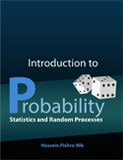10.1.4 Stationary Processes
Example
Consider the discrete-time random process $\big\{X(n), n \in \mathbb{Z} \cdots\}$, in which the $X(n)$'s are i.i.d. with CDF $F_{X(n)}(x)=F(x)$. Show that this is a (strict-sense) stationary process.
- Solution
- Intuitively, since $X(n)$'s are i.i.d., we expect that as time evolves the probabilistic behavior of the process does not change. Therefore, this must be a stationary process. To show this rigorously, we can argue as follows. For all real numbers $x_1, x_2,\cdots, x_r$ and all distinct integers $n_1$, $n_2$,$\cdots$, $n_r$, we have \begin{align}%\label{} &F_{X(n_1) X(n_2) \cdots X(n_r)}(x_1,x_2,\cdots, x_r)\\ & \quad =F_{X(n_1)}(x_1) F_{X(n_2)}(x_2) \cdots F_{X(n_r)}(x_r) \quad \textrm{ (since the $X(n_i)$'s are independent)}\\ & \quad =F(x_1)F(x_2) \cdots F(x_r) \quad \textrm{ (since $F_{X(t_i)}(x)=F(x)$)}. \end{align} We also have \begin{align}%\label{} &F_{X(n_1+D) X(n_2+D)\cdots X(n_r+D)}(x_1,x_2,\cdots, x_r)\\ & \quad =F_{X(n_1+D)}(x_1) F_{X(n_2+D)}(x_2) \cdots F_{X(n_r+D)}(x_r) \quad \textrm{ (since the $X(n_i+D)$'s are independent)}\\ & \quad =F(x_1)F(x_2) \cdots F(x_n) \quad \textrm{ (since $F_{X(n_i+D)}(x)=F(x)$)}. \end{align}
In practice, it is desirable if a random process $X(t)$ is stationary. In particular, if a process is stationary, then its analysis is usually simpler as the probabilistic properties do not change by time. For example, suppose that you need to do forecasting about the future of a process $X(t)$. If you know the process is stationary, you can observe the past, which will normally give you a lot of information about how the process will behave in the future.
However, it turns out that many real-life processes are not strict-sense stationary. Even if a process is strict-sense stationary, it might be difficult to prove it. Fortunately, it is often enough to show a "weaker" form of stationarity than the one defined above.
Weak-Sense Stationary Processes:
Here, we define one of the most common forms of stationarity that is widely used in practice. A random process is called weak-sense stationary or wide-sense stationary (WSS) if its mean function and its correlation function do not change by shifts in time. More precisely, $X(t)$ is WSS if, for all $t_1,t_2\in \mathbb{R}$ and all $\Delta \in \mathbb{R}$,- $E[X(t_1)]=E[X(t_2)]$,
- $E[X(t_1)X(t_2)]=E[X(t_1+\Delta)X(t_2+\Delta)]$.
- $\mu_X(t)=\mu_X$, for all $t\in \mathbb{R}$,
- $R_X(t_1,t_2)=R_X(t_1-t_2)$, for all $t_1,t_2 \in \mathbb{R}$.
- $\mu_X(n)=\mu_X$, for all $n\in \mathbb{Z}$,
- $R_X(n_1,n_2)=R_X(n_1-n_2)$, for all $n_1,n_2 \in \mathbb{Z}$.
Example
Consider the random process $\big\{X(t), t \in \mathbb{R}\big\}$ defined as \begin{align}%\label{} X(t)=\cos (t+U), \end{align} where $U \sim Uniform(0,2\pi)$. Show that $X(t)$ is a WSS process.
- Solution
-
We need to check two conditions:
- $\mu_X(t)=\mu_X$, for all $t\in \mathbb{R}$, and
- $R_X(t_1,t_2)=R_X(t_1-t_2)$, for all $t_1,t_2 \in \mathbb{R}$.
-
We need to check two conditions:
Since for WSS random processes, $R_X(t_1,t_2)=R_X(t_1-t_2)$, we usually denote the correlation function by $R_X(\tau)$, where $\tau=t_1-t_2$. Thus, for a WSS process, we can write \begin{align}\label{eq:RxWSS} R_X(\tau)=E[X(t)X(t-\tau)]=E[X(t+\tau)X(t)] \hspace{30pt} (10.1) \end{align} As we will see in Section 10.2, $R_X(\tau)$ is a very useful tool when we do frequency domain analysis. Here, we would like to study some properties of $R_X(\tau)$ for WSS signals. Let $\big\{X(t), t \in \mathbb{R}\big\}$ be a WSS process with correlation function $R_X(\tau)$. Then, we can write \begin{align}%\label{} R_X(0)=E[X(t)^2]. \end{align} The quantity $E[X(t)^2]$ is called the expected (average) power in $X(t)$ at time $t$. For a WSS process, the expected power is not a function of time. Since $X(t)^2 \geq 0$, we conclude that $R_X(0)\geq 0$.

Jointly Wide-Sense Stationary Processes:
We often work with multiple random processes, so we extend the concept of wide-sense stationarity to more than one process. More specifically, we can talk about jointly wide-sense stationary processes.- $X(t)$ and $Y(t)$ are each wide-sense stationary.
- $R_{XY}(t_1,t_2)=R_{XY}(t_1-t_2)$.
Example
Let $X(t)$ and $Y(t)$ be two jointly WSS random processes. Consider the random process $Z(t)$ defined as \begin{align*} Z(t) &=X(t)+Y(t). \end{align*} Show that $Z(t)$ is WSS.
- Solution
-
Since $X(t)$ and $Y(t)$ are jointly WSS, we conclude
- $\mu_X(t)=\mu_X$, $\mu_Y(t)=\mu_Y$,
- $R_X(t_1,t_2)=R_X(t_1-t_2)$, $R_Y(t_1,t_2)=R_Y(t_1-t_2)$,
- $R_{XY}(t_1,t_2)=R_{XY}(t_1-t_2)$.
-
Since $X(t)$ and $Y(t)$ are jointly WSS, we conclude
Cyclostationary Processes:
Some practical random processes have a periodic structure. That is, the statistical properties are repeated every $T$ units of time (e.g., every $T$ seconds). In other words, the random variables \begin{align}%\label{} X(t_1), X(t_2), \cdots, X(t_r) \end{align} have the same joint CDF as the random variables \begin{align}%\label{} X(t_1+T), X(t_2+T), \cdots, X(t_r+T). \end{align} Such random variables are called cyclostationary. For example, consider the random process $\big\{X(t), t \in \mathbb{R}\big\}$ defined as \begin{align}%\label{} X(t)=A \cos (\omega t), \end{align} where $A$ is a random variable. Here, we have \begin{align}%\label{} X\left(t+\frac{2 \pi}{\omega}\right)&=A \cos (\omega t+2 \pi)\\ &=A \cos (\omega t)=X(t). \end{align} We conclude $X(t)$ is in fact a periodic signal with period $T=\frac{2 \pi}{\omega}$. Therefore, the statistical properties of $X(t)$ do not change by shifting the time by $T$ units, so $X(t)$ is a cyclostationary random process with period $T=\frac{2 \pi}{\omega}$. Similarly, we can define wide-sense cyclostationary random processes.A continuous-time random process $\big\{X(t), t \in \mathbb{R}\big\}$ is weak-sense cyclostationary or wide-sense cyclostationary if there exists a positive real number $T$ such that
- $\mu_X(t+T)=\mu_X(t)$, for all $t\in \mathbb{R}$;
- $R_X(t_1+T,t_2+T)=R_X(t_1,t_2)$, for all $t_1,t_2 \in \mathbb{R}$.
- $\mu_X(n+M)=\mu_X$, for all $n\in \mathbb{Z}$;
- $R_X(n_1+M,n_2+M)=R_X(n_1,n_2)$, for all $n_1,n_2 \in \mathbb{Z}$.
Derivatives and Integrals of Random Processes:
Many real-life systems are described by differential equations. To analyze such systems when randomness is involved, we often need to differentiate or integrate the random processes that are present in the system. You have seen concepts such as continuity, differentiability, and integrability in calculus for deterministic signals (deterministic functions). Here, we need to extend those concepts to random processes. Without going much into mathematical technicalities, here we would like to provide some guidelines on how to deal with derivatives and integrals of random processes.
Let $X(t)$ be a continuous-time random process. We say that $X(t)$ is mean-square continuous at time $t$ if \begin{align*} \lim_{\delta\rightarrow 0} E\bigg[\big|X(t+\delta)-X(t)\big|^2\bigg]=0. \end{align*} Note that mean-square continuity does not mean that every possible realization of $X(t)$ is a continuous function. It roughly means that the difference $X(t+\delta)-X(t)$ is small on average.
Example
The Poisson process is discussed in detail in Chapter 11. If $X(t)$ is a Poisson process with intensity $\lambda$, then for all $t>s \geq 0$, we have \begin{align*} X(t)-X(s) \sim Poisson\big(\lambda (t-s)\big). \end{align*} Show that $X(t)$ is mean-square continuous at any time $t \geq 0$.
- Solution
- We have \begin{align*} X(t+\delta)-X(t) \sim Poisson\big(\lambda \delta\big). \end{align*} Thus, \begin{align*} \lim_{\delta\rightarrow 0} E[|X(t+\delta)-X(t)|^2]&= \lim_{\delta\rightarrow 0} \lambda \delta+(\lambda \delta)^2\\ &=0. \end{align*}
It is worth noting that there are jumps in a Poisson process; however, those jumps are not very "dense" in time, so the random process is still continuous in the mean-square sense. Figure 10.5 shows a possible realization of a Poisson process.

Example
Consider a random process $X(t)$ and its derivative, $X'(t)=\frac{d}{dt} X(t)$. Assuming that the derivatives are well-defined, show that \begin{align}%\label{} R_{XX'}(t_1,t_2)=\frac{\partial}{\partial t_2} R_X(t_1,t_2). \end{align}
- Solution
- We have \begin{align*}%\label{} R_{XX'}(t_1,t_2)&=E[X(t_1)X'(t_2)]\\ &=E\left[X(t_1)\frac{d}{dt_2} X(t_2)\right]\\ &=E\left[\frac{\partial}{\partial t_2} \bigg( X(t_1)X(t_2) \bigg) \right]\\ &=\frac{\partial}{\partial t_2} E\big[ X(t_1)X(t_2) \big]\\ &=\frac{\partial}{\partial t_2} R_X(t_1,t_2). \end{align*}

